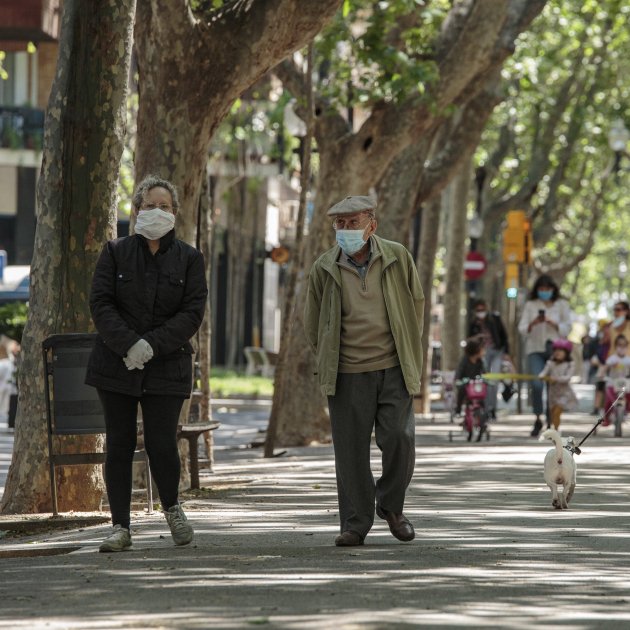No further easing of the lockdown rules for most of Catalonia - for another week at least. That's the probable consequence after the Catalan government today completed its proposal for the health regions of Catalonia which should move to Phase 1 of Spain's coronavirus deconfinement plan. The decision, made by Catalonia's PROCICAT civil protection committee, proposes that only three of Catalonia's health regions should access Phase 1 from next Monday, as ElNacional.cat has reported: the two Tarragona districts, Terres de l'Ebre and Camp de Tarragona, and the mountainous Alt Pirineu-Aran in Catalonia's north-west. These three regions, according to the health minister Alba Vergés, show a low risk of resurgence.
Thus, likely to be left out of any changes for the moment, and continuing with the current Phase 0 restrictions are the remaining health districts: all three Barcelona districts (Barcelona city, the northern metropolitan region, and the southern metropolitan region), and the three remaining zones Girona, Central Catalonia and Lleida. These are all classified as moderate risk, except for Barcelona city, which is defined as moderate-high risk, with a transmissibility index of 0.6.
However, the minister insisted that the trends of the epidemic are very positive in all districts, including Barcelona city. "We are in very good shape to be able to propose this deconfinement step in the coming days. It's not that Barcelona is doing badly but we need to give ourselves a few more days for it to work well," she said.
Under the current state of alarm, it is the Spanish health ministry under Salvador Illa which has the final decision on the parts of the state that will move forward to Phase 1. Vergés asserted that there is "maximum probability" that the ministry in Madrid will accept the Catalan government's proposal because it is "rigorous and backed by scientific criteria".
Risk of resurgence of the epidemic: green, low; orange, moderate; red, moderate-high.
The Catalan minister repeatedly stressed that no region of Catalonia has a high epidemiological risk, that the evolution of the epidemic is very positive in all areas, including Barcelona, that the figures have fallen sharply and that the health system has been able to respond. But she reiterated the need for a safe lifting of lockdown measures. "Today, community transmission of the virus continues. And we must continue to be cautious," she warned.
However, she affirmed that her ministry hopes to be able to make new proposals next week on the districts relating to the areas that are at moderate risk and, despite a reluctance to move ahead of events, when questioned, she did not rule out including Barcelona city.
In any case, she repeated, the deconfinement will be carried out "in a way that is safe, consensual and transparent", that "there is still community transmission of the virus" and that the impact varies depending on the territory. “Our country is diverse and the epidemic has also behaved differently across the territory,” she argued.
Impact of coronavirus by health districts: rates per 10,000 inhabitants of Positius (confirmed Covid-19 cases), Morts (deaths, confirmed and probable from Covid-19), Altes (recoveries of Covid-19 cases)
The decision of the PROCICAT civil protection committee is based on the analysis of the cumulative incidence of new cases over the last 14 days, which mark the current trend of the epidemic; and the rate of transmissibility, that is, the likelihood that any affected person will spread the virus.
The second key parameter in assessing the situation is the system's capacity for care and epidemiological surveillance, that is, its ability to respond to a new outbreak, through the identification of sources of infection and, within 48 hours, identifying close contacts and quarantining them.
Public health secretary Joan Guix explained that the indicators used also include a description of each territory - its demographic, sociological and economic characteristics - and the identification of points of special risk, such as senior citizens' residences.
All of this information is put together to create an overall index of Effective Growth Potential (EPG), which combines the cumulative incidence of Covid-19 over the last 14 days and the penetration rate over the last 7 days, and determines which territories are at risk of resurgent outbreaks of the virus: an EPG value of up to 30 is considered low risk; from 30 to 70, moderate risk; from 70 to 100, moderately high; and more than 100, high risk. According to this index, only the Alt Pirineu i Aran, Terres de l'Ebre and Camp de Tarragona are in the low risk category.
Under the Pedro Sánchez government's four-phase plan for lifting the Spanish state's lockdown, Phase 1 allows for the widespread opening of retail and commercial premises that are not in shopping centres, respecting a maximum occupancy of 30% of normal capacity and a 2 metre separation between people, with preferential time schedule for serving those over 70. Also able to open will be bar and restaurant terraces, limited to 30% of normal occupancy; hotels, without the use of common spaces, such as restaurants; libraries can open for lending and, with limited capacity, for reading; cultural events and shows of less than 30 people are allowed in enclosed spaces at one third of normal maximum occupying; in open spaces, up to 200 people will be allowed, seated and maintaining distances. The Phase 1 rules also permit active nature tourism with groups of limited size; audiovisual production and filming can resume; high-performance sports centres return to activity with restrictions and professional sports leagues will partially return to training; for non-professional sport, outdoor sports facilities without spectators will be permitted to open and sports activities can be held, by appointment, in sports centres, if they do not involve physical contact or the use of changing rooms.
